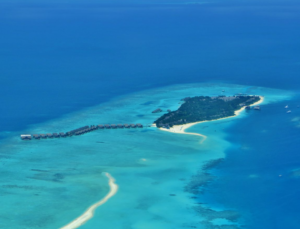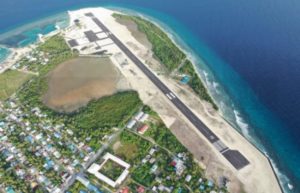by P. Homewood, May 6, 2021, in NotaLotofPeopleKnowThat
Over the years, the Guardian has assured us that the Maldives would soon be swamped, unless we mended our ways. Now they are happy to make money out of selling jet setting holidays there to its well heeled readers!
…
…
by C. Rotter, Dec 22, 2020 in WUWT
Reposted from NoTricksZone
By Kenneth Richard on 21. December 2020
Despite sea level rise, a 2019 global analysis (Duvat, 2019) found 89% of 709 island coasts have been either stable or growing in size in recent decades. A new Maldives-only study (Duvat, 2020) finds rapid (>3 to >50%) coastal growth in 110 of 186 Maldives islands from 2005 to 2016. Just 5 islands – 2.7% – actually contracted in size during this period.
Last year Dr. Virginie Duvat published a global assessment of how the Earth’s islands and atolls are faring against the ongoing challenge of sea level rise since satellite monitoring began in the 1980s.
Fortunately she found “no widespread sign of physical destabilization in the face of sea-level rise.” In fact, a) none of the 30 atolls analyzed lost land area, b) 88.6% of the 709 islands studied were either stable or increased in area, c) no island larger than 10 hectare (ha) decreased in size, and d) only 4 of 334 islands (1.2%) larger than 5 ha had decreased in size.
…
by P. Gosselin, Nov 20, 2020 in NoTricksZone
Despite all the money-generating gloomy predictions of sinking islands, we reported in 2013 on how the Maldives was planning to build 30 new luxury hotels for future tourists.

The resort island of Landaa Giraavaru (Baa atoll), photo by: Frédéric Ducarme – CC BY-SA 4.0.
Underwater in 7 years?
We recall how in 2012, the former President of the Maldives Islands, Mohamed, Nasheed said: “If carbon emissions continue at the rate they are climbing today, my country will be underwater in seven years.”
4 new airports!
Well, today the islands have not gone underwater and remains popular with tourists like never before. And to help with the job of ferrying the 1.7 million (2019) tourists to and from the resort islands, the Maldives have recently opened 4 new airports, according to German site Aero here!
…
by Maldives Insider, May 20, 2019
Five new airports will come into operation by the end of the year, Maldives government announced Sunday.
Transport minister Aishath Nahula told local media that construction of airports on the islands of Kulhudhuffushi in Haa Dhaal atoll, Funadhoo in Shaviyani atoll, Maafaru in Noonu atoll, Madivaru in Lhaviyani atoll and Maavarulu in Gaaf Dhaal atoll is nearing completion. Kulhudhuffushi airport will come into operation first, followed by Funadhoo and Maafaru airport in August, she said.
The airport being developed in Kulhudhuffushi, a key population zone in the north, and in Maafaru, a proposed ultra-luxury tourism zone, had earlier welcomed test flights. However, delays in the construction of terminal and other support facilities had pushed back commercial operations.
Six hectares off the southern coast of Kulhudhuffushi and another nine hectares from the island’s wetlands were reclaimed for the airport, which has a runway measuring 1,200 metres in length and 60 metres in width.
Known as the “Heart of the North”, Kulhudhuffushi is the economic capital of the northern Maldives and has a population of over 9,000, making it one of the biggest and most populous islands in the northern part of the country. The island is famous for its mangroves, after which the island itself is named.
…

by Michael Bastasch, September 21, 2018 in TheDailyCaller
Environmental officials warned 30 years ago the Maldives could be completely covered by water due to global warming-induced sea level rise.
That didn’t happen. The Indian Ocean did not swallow the Maldives island chain as predicted by government officials in the 1980s.
In September 1988, the Agence France-Presse (AFP) reported a “gradual rise in average sea level is threatening to completely cover this Indian Ocean nation of 1196 small islands within the next 30 years,” based on predictions made by government officials.
Then-Environmental Affairs Director Hussein Shihab told AFP “an estimated rise of 20 to 30 centimetres in the next 20 to 40 years could be ‘catastrophic’ for most of the islands, which were no more than a metre above sea level.”
…
by Nils-Axel Mörner, November 13, 2017 in WUWT
These are the facts
- Sea level has remained virtually at the present level over the last 200 years
- In the last 50-70 years sea level has remained perfectly stable in Fiji
- This stability is indicated by the growth of corals (stopped to grow vertically, and forced to grow laterally into microatolls) – and corals do not lie
We have (with references at the end)
o Studied your tide gauge records – Mörner & Matlack-Kelin, 2017a
o Studied sites of coastal erosion – Mörner & Matlack-Klein, 2017b
o Documented sea level change during the last 500 years in great details –
Mörner & Matlakc.Kelin, 2917c
o Noted the close similarity to similar records in nations like the Maldives,
Bangladesh and India – Mörner, 2017
o We have presented our data at conferences in Rome (4th WCCC, October 19-21, 2017) and Düsseldorf (11th EIKE, November 9-10, 2017) – see: Clutz, 2017 and Tallbloke’s Talkshop, 2017)
…
La géologie, une science plus que passionnante … et diverse


